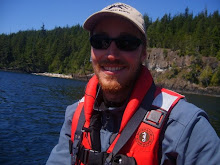
You know what I find inspiring? You thought I was going to say David Suzuki, didn't you? While I certainly do, David would be a 'who', not a 'what' (ah... grammar). Other inspiring things to which I am not referring here include:
- Sooty shearwaters which can fly over 64,000 km from the southern to the northern hemisphere and back in during their migration each year;
- Cuvier's beaked whales which can dive to depths of up to 2000 meters (6500 feet);
- And Spanish dancers (nudibranchs, that is) which are just dang cool!
But what I had in mind when I started writing this post is much greater and more awe inspiring. In broad terms, it's the night sky. More specifically, the Milky Way Galaxy (do we have any one from the Milky Way here tonight? Raise your hand). Very specifically, this video of the Milky Way, taken during a sandstorm on
Pico del Teide:
I've always found that the stars are best viewed from the deck of a ship out at sea (though I may change my mind if I ever have the chance to visit the Canary Islands), so I'm excited to tell you about a contest currently under way that could put your feet on such a deck. Namely, the
Way I Sea It contest.
Why am I excited to tell you about this? Because the prize is a seven-day Whales and Totems Tour of the Great Bear Rainforest with
Maple Leaf Adventures along British Columbia’s coast from August 28 to September 3, 2011. This adventure by sail on the 95-ton schooner
Maple Leaf with her gourmet chef and welcoming crew, features personal guides, whale watching, sailing, and hiking in and around the over 200 islands of the Broughton Archipelago.
But that's not the most exciting part. The lucky winner will also have the opportunity to write a few guest posts for our very own
Water Blogged. That's right, you could be featured on the very blog you're currently reading! I told you it was exciting, didn't I?Of course, I would be much more excited about the awesome sailing adventure, but it turns out that I can't apply (staff ineligibility, something-or-other). So It's all up to you now. All you have to do is click
here, and follow the instructions. Want to read the instructions first? Simply write an answer to the following question in 300 words or less:
What opportunities, decisions, serendipity, adventures or choices led you to your current path? The way you make a difference in the world could be anything, big or small - a hobby, a career, a volunteer activity, a way of life, a philosophy.
Then, increase your chances of winning simply by asking people to vote for you. Judges (no, I’m not one of them) will pick the winner from the top 5 contestants with the most votes. The winner also get to blog (read, brag) about their trip for Living Oceans’ blog. The sooner you get your entry up, the more time you will have to get more votes, so enter now!
There are already a number of great entries, which you can check out
here. If you don't feel like entering, than you can vote for your favorite (did I mention I don't get to vote either?). So check it out, and you or someone you know could be sailing off into the sunset this summer.
I'll wave at you from my office.
Now here's the fine print (I may have added a few conditions):
No purchase necessary. Residents of Canada excluding Quebec are eligible to enter. Must be a resident of the Milky Way Galaxy to enter. The one prize is a trip for one from Vancouver to Port McNeil with Maple Leaf Adventures and worth approximately $3,875, and the opportunity to write two to five blog posts for the Living Oceans Society. LOS reserves the right to refuse to publish any material pertaining to Justin Bieber in any way shape or form. To enter, contestants must clearly write a short story and be one of the five contestants to get the most votes. Contestants who owe John money are ineligible. Judges will choose one contest winner from the five contestants with the most votes. The contest closes on June 5, 2011.


 Once in a while, a video comes along that explains, in a few minutes, everything you've been trying to say for years. Two days ago such a video was released by filmmaker Ben Gulliver: Tipping Barrels – Journey into the Great Bear Rainforest. With beautiful footage by Ben Gulliver and Ian McAllister, Tipping Barrels follows surfers Arran and Reid Jackson on a trip into the heart of the Great Bear Rainforest.
Once in a while, a video comes along that explains, in a few minutes, everything you've been trying to say for years. Two days ago such a video was released by filmmaker Ben Gulliver: Tipping Barrels – Journey into the Great Bear Rainforest. With beautiful footage by Ben Gulliver and Ian McAllister, Tipping Barrels follows surfers Arran and Reid Jackson on a trip into the heart of the Great Bear Rainforest.



















